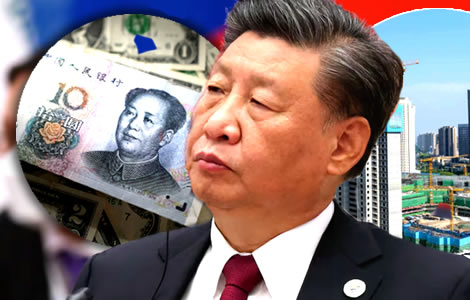Xi Jinping’s U-turn on fiscal measures aims to prop up the struggling property sector and local governments. But doubts linger over whether this will be enough to stave off deflation and economic decline. Is China facing a Japan-style stagnation?
Analysts are trying to predict how far China will go since its about-turn on stimulus measures, particularly efforts to prop up the property sector and struggling local governments. Undoubtedly, something has changed at the top. Nonetheless, Western analysts and observers are sceptical that what is afoot will be enough to save the Chinese economy. They fear the forces of deflation and an economic decline driven by demographics. Indeed, it has been suggested that China may go the same way as Japan, where an ageing population stagnated growth in the economy. At the same time, there is also uncertainty as to whether China ultimately has the firepower to see such an undertaking through. Critically, there is concern that China’s efforts to pump money into a struggling economy will backfire. Undoubtedly, the stakes are high with a population that has become accustomed to economic success.

Xi Jinping’s sudden policy shift towards fiscal stimulus has jolted the Chinese economy. After resisting calls for years to introduce a major economic package, Beijing’s leadership recently made a dramatic U-turn.
However, questions remain about whether these measures will be enough to revitalise the world’s second-largest economy.
Shanghai brokers face stress test amid massive market disruption following stimulus announcement
While most of China celebrated its weeklong national holiday in early October, brokers in Shanghai were hard at work.
The Shanghai Stock Exchange mandated a sector-wide stress test of trading systems following a dramatic market crash just days before. That crash occurred when Beijing announced its largest fiscal stimulus since the pandemic, sending China’s 220 million retail investors scrambling to buy stocks.
The surge in orders overwhelmed the system, causing a market-wide disruption. “This is the first time in over a decade of my career that I’ve seen a sector-wide test,” said an anonymous broker at a mid-sized firm in Shanghai. The system overload, he explained, felt like a coordinated cyberattack.
The shock waves from the stimulus announcement reflect the broader uncertainty within China’s economy as markets and analysts alike question what the future holds.
Xi’s reluctance to act on struggling economy leads to fears of missing GDP growth targets
For years, Xi Jinping and his team have resisted calls for a large fiscal stimulus package, despite a struggling economy. China’s real estate sector, once a major driver of growth, has slumped for three consecutive years.
This sector alone once accounted for nearly 30% of the country’s economic activity. As property prices continued to fall and local governments faced crippling debt, Beijing’s reluctance to intervene led to fears that China might miss its 5% GDP growth target for the year.
Markets rally on reports China’s politburo may move to reflate its troubled economy with stimulus
Indeed, recent economic data only deepened these concerns. In the third quarter of 2023, China’s GDP growth hit 4.6%, marking the slowest growth in 18 months. With local governments unable to pay bills and economic activity stalling, the urgency to act became impossible to ignore.
China launches multi-pronged stimulus effort to address economic challenges
In response, China’s central bank and financial regulators launched a multi-pronged stimulus effort. Interest rates were slashed, support for the stock market was bolstered, and new assistance for homeowners was introduced.
Soon after, the Ministry of Finance announced a sweeping plan aimed at local governments, large banks, and the housing sector. The plan includes bailing out local authorities, recapitalizing major banks, and purchasing millions of unsold apartments.
Although Beijing has not disclosed the full size of the fiscal package, it has hinted that some components will be the largest in “recent years.” Investors, however, are left wondering whether this “combination punch” of policies will be enough to reverse China’s economic decline.
Deep structural challenges remain despite new stimulus measures from Beijing
Despite the optimism surrounding Beijing’s latest moves, deep structural challenges persist. China’s demographic decline, high government debt, youth unemployment, and strained relations with major trading partners weigh heavily on its long-term growth prospects.
Economists warn that China’s problems cannot be solved by short-term fiscal measures alone. The consequences of failure are severe. Some fear China could face a deflationary spiral, similar to Japan’s post-bubble economy in the 1990s.
Japan has struggled for decades to recover fully from the collapse of its real estate market. A similar fate for China could derail Xi’s ambitious goal of doubling the nation’s per capita GDP by 2035, a key element of his plan to surpass the U.S. as the world’s largest economy.
Moreover, economic stagnation could fuel discontent among the Chinese public, who have come to expect steady improvements in living standards. Xi, known for his political resilience, faces the tough challenge of managing these economic risks while maintaining public support.
Xi Jinping adjusts economic strategy to focus on long-term growth and innovation
Many analysts believe Xi is adjusting his long-held economic strategy to match the changing realities of the Chinese economy. In the past, China relied heavily on debt-driven infrastructure projects and manufacturing to drive growth.
But this strategy has led to inefficiencies and ballooning debt. Now, Xi is looking to refocus China’s growth efforts on what he calls “new productive forces.” These include green energy, high-tech industries, and advanced manufacturing, particularly in sectors like semiconductors.
By shifting focus, Xi hopes to make the economy more resilient and innovative, capable of sustaining long-term growth.
“We are seeing fundamental shifts in both the way Xi views the state of the economy and his approach to addressing the problems,” said Andy Rothman, an investment strategist at Matthews Asia fund. “Xi now recognises that China’s economy is on the wrong track, and that a pragmatic course correction is urgently needed.”
Xi’s sudden change in economic course raises questions among investors and experts
Even though China had taken incremental steps to stimulate the economy in the last year, Xi Jinping publicly showed little concern about economic slowdown until his administration’s sudden announcement.
Just weeks before the stimulus measures were revealed, Xi was pictured smiling and cheerful during a visit to Gansu province, where he paid respects to China’s mythical first emperor and mingled with farmers and military personnel.
Why Xi decided to change his course remains unclear to investors. What is evident, however, is that this new direction represents a critical moment for China. The stakes are high, and whether this stimulus package will succeed remains to be seen.
What is clear is that China’s path to recovery will require more than just immediate fiscal boosts—it will demand a fundamental transformation of its economic model.
Join the Thai News forum, follow Thai Examiner on Facebook here
Receive all our stories as they come out on Telegram here
Follow Thai Examiner here
Further reading:
Markets rally on reports China’s politburo may move to reflate its troubled economy with stimulus
Disturbing questions that must be confronted over Thailand’s reeling economy are China and EV cars
First-quarter GDP growth surprises analysts based on higher tourism and consumer spending growth
Central bank holds interest rates. Economy will grow 2.6% in 2024 as Srettha pushes home ownership


















